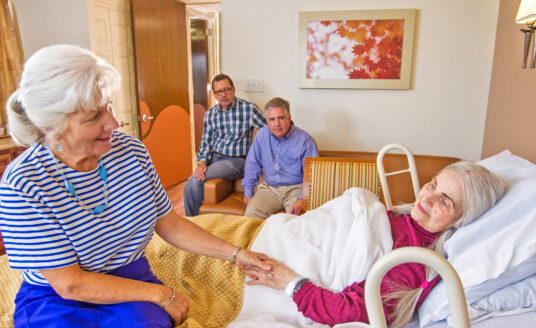As people age, their risk of loneliness increases. Not all older adults will get lonely, but feelings of loneliness often rise after people turn 50. A variety of factors contribute to this trend, including shrinking social networks, the loss of a spouse, and friends who may move or pass away.
Let’s dig into four key strategies for preventing or reducing senior loneliness, including the essential role of senior independent living communities.
Strategies to Prevent Senior Loneliness
Taking proactive steps to prevent senior loneliness is essential for maintaining your loved one’s mental and physical health. The following four strategies can make a difference.
1. Stay socially active.
Social connectedness is a key element of maintaining mental and emotional well-being. This means cultivating quality relationships that “create a sense of belonging, and being cared for, valued, and supported.”
Maintaining these relationships has a measurable impact on a person’s quality of life. Healthy, dynamic social connections can help someone bounce back more easily from stress, depression, and anxiety. They also enhance overall well-being and reduce the risk of death from chronic disease.
Engaging in social activities is key to preventing loneliness, but your parent or loved one may not know how to broaden their social circle. Encourage them to seek out organized groups that share common interests, such as:
- Community groups and senior centers in the area
- Hobby groups or classes
- A book club at a local library or bookshop
- Volunteer opportunities, either in person or virtually
- Local religious or cultural events
2. Connect through technology.
Access to technology, such as tablets and computers, is more common than ever, and staying socially connected only requires reaching into a purse or pocket for a smartphone. These days, all major technology brands include accessibility features to assist older adults, such as magnification to improve text readability and adaptive settings to assist those with motor difficulties.
Whether your senior loved one is hindered by geographical distance or mobility challenges, they can stay socially connected via regular video calls to friends and family both near and far. Social media sites also provide access to old friends and online communities where new friends can be found. According to AARP, people aged 50 and older flock to Facebook, YouTube, Instagram, and Pinterest.
3. Take time for overall physical and mental wellness.
Regular physical activity provides a treasure trove of benefits—not only in terms of physical health but also when it comes to mental health and social connections. Joining a fitness center or attending fitness classes will give seniors an opportunity to meet new people. If your loved one has a dog (or wants to adopt one!), in addition to the inherent health benefits of owning a pet, they’ll enjoy the social opportunity to join a walking club.
Studies show that exercise improves mental health by lowering the risk of anxiety and depression, and it can improve cognitive function over time. Beyond physical activity, other strategies for maintaining mental well-being include:
- Meditating regularly
- Practicing mindfulness
- Seeking mental health and medical care when necessary
4. Get involved in support networks.
Plenty of resources are available to prevent seniors from experiencing loneliness, including community centers, companionship programs, counseling services, support groups, and more. You can find many of these resources in person or online, so connection is possible no matter where you’re located.
Looking for a place to connect? Start with the following:
- AARP Support Services: Find ways to socially plug in and get help meeting practical needs such as housing, food, and healthcare.
- AARP Virtual Community Center: This online community center is packed with virtual educational activities and social opportunities.
- AmeriCorps Seniors: Discover volunteer opportunities for people 55 and over.
Senior Independent Living Communities Improve Social Connectedness
A sense of community and belonging is critical to combating loneliness. Residents of senior independent living communities enjoy easy access to many of the resources we’ve discussed because these communities are designed to prioritize socialization.
Senior independent living communities offer regular, convenient opportunities for connection that can prevent loneliness. On-campus services and amenities help residents meet new people, keep up with old friends, and interact with family members. Examples include crafting groups, exercise classes, and places to gather and share a meal and good conversation—all of which are just a step outside your loved one’s front door.
Would a senior independent living community be the right fit for your parent or senior loved one? Our quiz can help you discover the benefits and decide.
Want to find out more?
If you’d like to stay up to date with Bethesda Health Group, sign up here to receive our blog and newsletters!
"*" indicates required fields
Related Articles
Want to find out more?
If you’d like to stay up to date with Bethesda Health Group, sign up here to receive our blog and newsletters!
"*" indicates required fields





